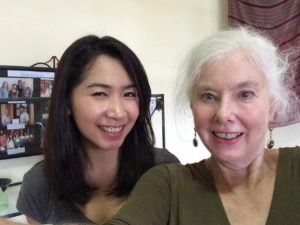When I was in Bangkok a couple of years ago I went to visit Wat Pho, the temple of the reclining Buddha. The Buddha is 150 feet long and gold-plated. He rests with his head on his hand and he is smiling slightly, as if he were basking in the very same divine radiance that lent him his own golden color.
At the Buddha’s head a young woman was taking a selfie. She had positioned her own head and hand like his and arranged her face in her best Buddha smile.
I started asking myself the purpose of selfies. If you feel there’s a moment in your life that you need to capture and no one else is there to do the job, the smart phone makes it possible to prove your moment was real.
But what moments of our life do we choose to record? And why? And, perhaps most important of all, who are they for? What we are saying with our selfies is, in effect, I am living a meaningful life, and here’s proof. It’s almost as if our experiences have no relevance if we only see and hear and touch them, and then they just slip away. We pass through our moments. They may remain forever in our memories, but without the selfie, only we ourselves are witness to the fact that those experiences touched us as we touched them, that they enfolded us. By inserting ourselves in the photo, we offer evidence that we are full participants in our own life.
Confession: On that same trip in which I saw the women pose like a Buddha, I took a selfie in Bali with my Indonesian language teacher (above). Honestly, the reason I did so was because I was proud of myself for learning how to speak Indonesian and I wanted to show my friends my teacher and me together, as if that were proof that I had learned well.
Do you ever take selfies? And if so, of what? When? Why?
What I’m reading
I’m reading Reporter by Seymour Hersh. I read an excerpt of this book by America’s foremost investigative reporter in Harper’s. The article described how he tracked down Lt. William Calley, who was responsible for perpetrating the disaster in the Vietnamese village of My Lai in 1968. I had imagined that the whole book would be about Hersh’s clever ruses to find people who would give him information, but the more the book went along, the more it was about U.S. policy outrages themselves, rather than how he learned and wrote about them. It also got a little tiresome that, according to Hersh, anyone who edited him or questioned his tactics or fact-checked him too thoroughly was a coward or nitpicker. Get the Harper’s article and read the story about Calley instead.
Other News
I have a new calendar for 2019, illustrated with Japanese woodblock prints, and I look forward to filling it in. I’ll be home till the end of January and looking forward to beginning work with a new Radical Joy for Hard Times board. At the end of the month I’ll be going to England to do a workshop with ArtGym in Kent.
